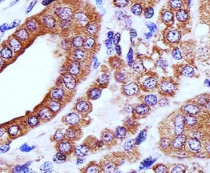ARG54816
anti-ATG3 antibody [1377CT239.6.1.12]
anti-ATG3 antibody [1377CT239.6.1.12] for IHC-Formalin-fixed paraffin-embedded sections,Western blot and Human,Mouse
Cancer antibody; Cell Biology and Cellular Response antibody; Cell Death antibody; Metabolism antibody; Neuroscience antibody
Overview
| Product Description | Mouse Monoclonal antibody recognizes ATG3 |
|---|---|
| Tested Reactivity | Hu, Ms |
| Tested Application | IHC-P, WB |
| Host | Mouse |
| Clonality | Monoclonal |
| Clone | 1377CT239.6.1.12 |
| Isotype | IgG1, kappa |
| Target Name | ATG3 |
| Antigen Species | Human |
| Immunogen | Recombinant protein of Human ATG3. |
| Conjugation | Un-conjugated |
| Alternate Names | Ubiquitin-like-conjugating enzyme ATG3; EC 6.3.2.-; APG3-LIKE; Protein PC3-96; APG3; Autophagy-related protein 3; PC3-96; APG3L; hApg3; APG3-like |
Application Instructions
| Application Suggestion |
|
||||||
|---|---|---|---|---|---|---|---|
| Application Note | * The dilutions indicate recommended starting dilutions and the optimal dilutions or concentrations should be determined by the scientist. | ||||||
| Positive Control | Mouse liver |
Properties
| Form | Liquid |
|---|---|
| Purification | Purification with Protein G. |
| Buffer | PBS and 0.09% (W/V) Sodium azide |
| Preservative | 0.09% (W/V) Sodium azide |
| Storage Instruction | For continuous use, store undiluted antibody at 2-8°C for up to a week. For long-term storage, aliquot and store at -20°C or below. Storage in frost free freezers is not recommended. Avoid repeated freeze/thaw cycles. Suggest spin the vial prior to opening. The antibody solution should be gently mixed before use. |
| Note | For laboratory research only, not for drug, diagnostic or other use. |
Bioinformation
| Database Links |
Swiss-port # Q9CPX6 Mouse Ubiquitin-like-conjugating enzyme ATG3 Swiss-port # Q9NT62 Human Ubiquitin-like-conjugating enzyme ATG3 |
|---|---|
| Gene Symbol | ATG3 |
| Gene Full Name | autophagy related 3 |
| Background | This gene encodes a ubiquitin-like-conjugating enzyme and is a component of ubiquitination-like systems involved in autophagy, the process of degradation, turnover and recycling of cytoplasmic constituents in eukaryotic cells. This protein is known to play a role in regulation of autophagy during cell death. A pseudogene of this gene is located on chromosome 20. Alternative splicing results in multiple transcript variants encoding different isoforms. [provided by RefSeq, Jul 2013] |
| Function | E2 conjugating enzyme required for the cytoplasm to vacuole transport (Cvt), autophagy, and mitochondrial homeostasis. Responsible for the E2-like covalent binding of phosphatidylethanolamine to the C-terminal Gly of ATG8-like proteins (GABARAP, GABARAPL1, GABARAPL2 or MAP1LC3A). The ATG12-ATG5 conjugate plays a role of an E3 and promotes the transfer of ATG8-like proteins from ATG3 to phosphatidylethanolamine (PE). This step is required for the membrane association of ATG8-like proteins. The formation of the ATG8-phosphatidylethanolamine conjugates is essential for autophagy and for the cytoplasm to vacuole transport (Cvt). Preferred substrate is MAP1LC3A. Also acts as an autocatalytic E2-like enzyme, catalyzing the conjugation of ATG12 to itself, ATG12 conjugation to ATG3 playing a role in mitochondrial homeostasis but not in autophagy. ATG7 (E1-like enzyme) facilitates this reaction by forming an E1-E2 complex with ATG3. Promotes primary ciliogenesis by removing OFD1 from centriolar satellites via the autophagic pathway. [UniProt] |
| Cellular Localization | Cytoplasm. |
| Research Area | Cancer antibody; Cell Biology and Cellular Response antibody; Cell Death antibody; Metabolism antibody; Neuroscience antibody |
| Calculated MW | 36 kDa |
| PTM | Conjugated to ATG12 at Lys-243. ATG12-conjugation plays a role in regulation of mitochondrial homeostasis and cell death, while it is not involved in PE-conjugation to ATG8-like proteins and autophagy. Cleaved by CASP8 upon death ligand binding such as tumor necrosis factor-alpha. CASP8 cleavage blocks survival-related autophagy and favors apoptosis. |
Images (2) Click the Picture to Zoom In







